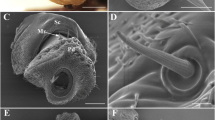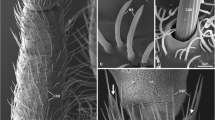Abstract
Melophagus ovinus (Linnaeus 1758), Hippobosca equina Linnaeus, 1758, and Hippobosca longipennis Fabricius, 1805 (Diptera: Hippoboscidae) are economically and medically important ectoparasites that can act as mechanic vectors of pathogens and cause myiasis in both human and domestic animals. As essential olfactory organs, antennae of these adult hippoboscids were examined using stereoscopic and scanning electron microscopes. General morphology of the antenna is provided in detail, combined with distribution, types, size, and ultrastructures of antennal sensilla. On the antennal funiculus, two types of sensilla are observed, including basiconic sensilla and coeloconic sensilla. Four common characters are shared among the three species: (1) the scape is either obsolete or fused with the fronto-clypeus; (2) branched antennal structures (branched pedicellar microtrichiae and branched arista with only one segment) are detected; (3) the enlarged antennal pedicel completely envelops the antennal funiculus; and (4) less types of sensilla on funiculus. Disparity and diversity of the antennal and sensory structures are analyzed from the phylogenetic and functional perspective. We suggest that hippoboscids are potential model for the study of the function of coeloconic sensilla in Calyptratae.








Similar content being viewed by others
References
Abadi Y (2000) Current problems of the leather industry. In: Merkel RC, Abebe G, Goetsch AL (eds) The opportunities and challenges of enhancing goat production in east Africa. Institute for Goat Research, Langston University, Langston, pp 139–143
Altner H, Schaller-Selzer L, Stetter H, Wohlrab I (1983) Poreless sensilla with inflexible sockets; a comparative study of a fundamental type of insect sensilla probably comprising thermo- and hygroreceptors. Cell Tissue Res 234:279–307
Baker JR (1967) A review of the role played by the Hippoboscidae (Diptera) as vectors of endoparasites. J Parasitol 1967:412–418
Berhanu W, Negussie H, Alemu S, Mazengia H (2011) Assessment on major factors that cause skin rejection at Modjo export tannery, Ethiopia. Trop Anim Health Prod 43:989–993
Colwell DD, Hall MJR, Scholl PJ (2006) The Oestrid flies: biology, host-parasite relationships, impact and management. CABI Publishing, Cambridge
Decastello A, Farkas R (2009) Anaphylactic reaction caused by a horse–fly species (Hippobosca equina). Orv Hetil 150:1945–1948
Fernandes FF, Freitas EPS, Linardi PM, Pimenta PFP (2005) Ultrastructure of contact-chemoreceptor sensilla found among the genae of female Gasterophilus nasalis. J Parasitol 91:1218–1220
Gemeda N, Mokonnen W, Lemma H, Tadele A, Urga K, Addis G, Debella A, Getachew M, Teka F, Yirsaw K, Mudie K, Gebre S (2014) Insecticidal activity of some traditionally used Ethiopian medicinal plants against sheep ked Melophagus ovinus. J Parasitol Res. doi:10.1155/2014/978537
Gibson W, Pilkington JG, Pemberton JM (2010) Trypanosoma melophagium from the sheep ked Melophagus ovinus on the island of St Kilda. Parasitol 137:1799–1804
Griffiths GCD (1972) Series entomologica. In: Junk W (ed) The phylogenetic classification of Diptera Cyclorrhapha, with special reference to the male postabdomen. Springer, Hague, pp 1–335
Hallem EA, Dahanukar A, Carlson JR (2006) Insect odor and taste receptors. Annu Rev Entomol 51:113–135
Hunter FF, Adserballe CF (1996) Cuticular structures on the antennae of Hypoderma bovis De Geer (Diptera: Oestridae) females. J Eukaryot Microbiol 25:173–181
Jobling B (1928) The structure of the head and mouth-parts in the Nycteribiidae (Diptera Pupipara). Parasitol 20:254–272
Jobling B (1929) A comparative study of the structure of the head and mouth parts in the Streblidae (Diptera Pupipara). Parasitol 21:417–445
Kumsa B, Parola P, Raoult D, Socolovschi C (2014) Bartonella melophagi in Melophagus ovinus (sheep ked) collected from sheep in northern Oromia, Ethiopia. Comp Immunol Microbiol Infect Dis 37:69–76
Luedke AJ, Jochim MM, Bowne JG (1965) Preliminary bluetongue transmission with the sheep ked Melophagus ovinus (L.). Can J Comp Med Vet Sci 29:229–231
Maa TC (1962) Notes on the Hippoboscidae (Diptera). Pac Insects 4:583–614
Martinkovic F, Matanovic K, Rodrigues AC, Garcia HA, Teixeira MM (2012) Trypanosoma (Megatrypanum) melophagium in the sheep ked Melophagus ovinus from organic farms in Croatia: phylogenetic inferences support restriction to sheep and sheep keds and close rela–tionship with trypanosomes from other ruminant species. J Eukaryot Microbiol 59:134–144
Mathieson AO (1991) Ectoparasites and their control. In: Martin WB, Aitken ID (eds) Diseases of sheep, 2nd edn. Blackwell Science Publication, Oxford, pp 284–289
McIver SB (1969) Antennal sense organs of female Culex tarsalis (Diptera: Culicidae). Ann Entomol Soc Am 62:1455–1461
Nelson WA, Slen SB (1968) Weight gains and wool growth in sheepinfested with the sheep ked Melophagus ovinus. Exp Parasitol 22:223–226
Ochieng SA, Park KC, Zhu JW, Baker TC (2000) Functional morphology of antennal chemoreceptors of the parasitoid Microplitis croceipes (Hymenoptera: Braconidae). Arthropod Struct Dev 29:231–240
Olson DM, Andow DA (1993) Antennal sensilla of female Trichogramma nubilale (Ertle and Davis) (Hymenoptera: Trichogrammatidae) and comparisons with other parasitic Hymenoptera. Int J Insect Morphol Embryol 22:507–520
Pape T (2001) Phylogeny of Oestridae (Insecta: Diptera). Syst Entomol 26:133–171
Petersen FT, Meier R, Kutty SN, Wiegmann BM (2007) The phylogeny and evolution of host choice in the Hippoboscoidea (Diptera) as reconstructed using four molecular markers. Mol Phylogenet Evol 45:111–122
Pfadt RE (1976) Sheep ked populations on a small farm. J Econ Entomol 69:313–316
Poddighe S, Dekker T, Scala A, Angioy AM (2010) Olfaction in the female sheep botfly. Naturwissenschaften 97:827–835
Pollock JN (2010) Bot flies (Insecta: Oestridae, part) and Glossinidae–Hippoboscidae derive from basal Ephydroidea, not Calyptratae. J Nat Hist 44:1929–1952
Rani PA, Coleman GT, Irwin PJ, Traub RJ (2011) Hippobosca longipennis—a potential intermediate host of a species of Acanthocheilonema in dogs in northern India. Parasit Vectors 4:143
Renthal R, Velasquez D, Olmos D, Hampton J, Wergin WP (2003) Structure and distribution of antennal sensilla of the red imported fire ant. Micron 34:405–413
Rospars JP (1988) Structure and development of the insect antennodeutocerebral system. Int J Insect Morphol Embryol 17:243–294
Ross KTA (1992) Comparative study of the antennal sensilla of fivespecies of root maggots: Delia radicum L., D. floralis F., D. antique Mg., D. platura Mg. (Diptera: Antomyiidae), and Psila rosae F. (Diptera: Psilidae). Int J Insect Morphol Embryol 21:175–197
Setzu MD, Poddighe S, Angioy AM (2011) Sensilla on the antennal funiculus of the blow fly, Protophormia terraenovae (Diptera: Calliphoridae). Micron 42:471–477
Shanbhag SR, Singh K, Singh RN (1995) Fine structure and primary sensory projections of sensilla located in the sacculus of the antenna of Drosophila melanogaster. Cell Tissue Res 282:237–249
Shanbhag SR, Muller B, Steinbrecht RA (2000) Atlas of olfactory organs of Drosophila melanogaster 2. Internal organization and cellular architecture of olfactory sensilla. Arthropod Struct Dev 29:211–229
Small RW (2005) A review of Melophagus ovinus (L.), the sheep ked. Vet Parasitol 130:141–155
Smallegange RC, Kelling RJ, Den Otter CJ (2008) Types and numbers of sensilla on antennae and maxillary palps of small and large houseflies, Musca domestica (Diptera, Muscidae). Microsc Res Tech 71:880–886
Sukontason K, Sukontason KL, Piangjai S, Boonchu N, Chaiwong T, Ngern-klun R, Sripakdee D, Vogtsberger RC, Olson JK (2004) Antennal sensilla of some forensically important flies in families Calliphoridae, Sarcophagidae and Muscidae. Micron 35:671–679
Sukontason K, Methanitikorn R, Chaiwong T, Kurahashi H, Vogtsberger RC, Sukontason KL (2007) Sensilla of the antenna and palp of Hydrotaea chalcogaster (Diptera: Muscidae). Micron 38:218–223
Wallach AD, Shanas U, Mumcuoglu KY, Inbar M (2008) Ectoparasites on reintroduced roe deer Capreolus capreolus in Israel. J Wildlife Dis 44:693–696
Wiegmann BM, Trautwein MD, Winkler IS, Barr NB, Kim JW, Lambkin C, Bertone MA, Cassel BK, Bayless KM, Heimberg AM, Wheeler BM, Peterson KJ, Pape T, Sinclair BJ, Skevington JH, Blagoderov V, Caravas J, Kutty SN, Schmidt-Ott U, Kampmeier GE, Thompson FC, Grimaldi DA, Beckenbach AT, Courtney GW, Friedrich M, Meier R, Yeates DK (2011) Episodic radiations in the fly tree of life. Proc Natl Acad Sci U S A 108:5690–5695
Yeates DK, Wiegmann BM (2005) Phylogeny and evolution of Diptera: recent insights and new perspectives. In: Yeates DK, Wiegmann BM (eds) The evolutionary biology of flies. Columbia University Press, New York, pp 14–44
Zacharuk RY (1985) Antennal sensilla. In: Kerkut GA, Gilbert LI (eds) Comparative insect physiology. Pergamon Press, Oxford, pp 1–69
Zhang D, Wang QK, Hu DF, Li K (2012a) Cuticular structures on antennae of the bot fly, Portschinskia magnifica (Diptera: Oestridae). Parasitol Res 111:1651–1659
Zhang D, Wang QK, Hu DF, Li K (2012b) Sensilla on the antennal funiculus of the stomach bot fly, Gasterophilus nigricornis (Diptera: Oestridae). Med Vet Entomol 26:314–322
Zhang D, Wang QK, Liu XH, Li K (2013a) Sensilla on antenna and maxillary palp of predaceous fly, Lispe neimongola Tian et Ma (Diptera: Muscidae). Micron 49:33–39
Zhang D, Liu XH, Li XY, Zhang M, Li K (2013b) Antennal sensilla of the green bottle fly, Lucilia sericata (Meigen) (Diptera: Calliphoridae). Parasitol Res 112:3843–3850
Zumpt F (1965) Myasis in man and animals in the Old world. Butterworth, London
Acknowledgments
We are grateful to Dr. Qike Wang (University of Melbourne, Melbourne, Austrilia) for his help with revising this paper. This study was supported by the Beijing Higher Education Young Elite Teacher Project (No. YETP0771), the Program for New Century Excellent Talents in University (No. NCET-12-0783), and the National Science Foundation of China (No. 31201741).
Author information
Authors and Affiliations
Corresponding author
Rights and permissions
About this article
Cite this article
Zhang, D., Liu, X.H., Li, X.Y. et al. Ultrastructural investigation of antennae in three cutaneous myiasis flies: Melophagus ovinus, Hippobosca equina, and Hippobosca longipennis (Diptera: Hippoboscidae). Parasitol Res 114, 1887–1896 (2015). https://doi.org/10.1007/s00436-015-4376-4
Received:
Accepted:
Published:
Issue Date:
DOI: https://doi.org/10.1007/s00436-015-4376-4




